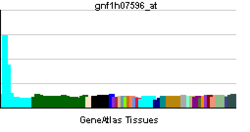Receptor žučne kiseline
| edit |
| G protein-spregnuti receptor žučne kiseline 1 | |||||||||||
|---|---|---|---|---|---|---|---|---|---|---|---|
| Identifikatori | |||||||||||
| Simboli | GPBAR1; BG37; GPCR19; GPR131; M-BAR; MGC40597; TGR5 | ||||||||||
| Vanjski ID | OMIM: 610147 MGI: 2653863 HomoloGene: 18125 IUPHAR: GPBA GeneCards: GPBAR1 Gene | ||||||||||
| |||||||||||
| Pregled RNK izražavanja | |||||||||||
 | |||||||||||
| podaci | |||||||||||
| Ortolozi | |||||||||||
| Vrsta | Čovek | Miš | |||||||||
| Entrez | 151306 | 227289 | |||||||||
| Ensembl | ENSG00000179921 | ENSMUSG00000064272 | |||||||||
| UniProt | Q8TDU6 | Q14AA9 | |||||||||
| RefSeq (mRNA) | NM_001077191 | NM_174985 | |||||||||
| RefSeq (protein) | NP_001070659 | NP_778150 | |||||||||
| Lokacija (UCSC) | Chr 2: 218.83 - 218.84 Mb | Chr 1: 74.21 - 74.21 Mb | |||||||||
| PubMed pretraga | [1] | [2] | |||||||||
Receptor žučne kiseline je G-protein spregnuti receptor koji vezuje žučne kiseline.[1] Jedan od efekata ovog receptora je aktivacija enzima dejodinaza, koji konvertuje prohormon tiroksin (T4) u aktivni hormon trijodotironin (T3). T3 zatim aktivira receptor tiroidnog hormona koji uvećava metaboličku stopu.[2][3]
Ovaj gen kodira protein koji je član familije G protein-spregnutih receptora. On dejstvuje kao receptor na ćelijskoj površini za žučnu kiselinu. Izlaganje ćelija koje izražavaju ovaj GPCR žučnoj kiselini uzrokuje produkciju intraćelijskog cAMP, aktivaciju signalnog puta MAP kinaza, i internalizaciju receptora. Za ovaj receptor se smatra da učestvuje u supresiji funkcija makrofaga i regulacije energije homeostaze žučnim kiselinama. Alternativno splajsovanje stvara transkriptne varijante koje kodiraju isti protein.[4]
Reference[uredi | uredi kod]
- ↑ Kawamata Y, Fujii R, Hosoya M, Harada M, Yoshida H, Miwa M, Fukusumi S, Habata Y, Itoh T, Shintani Y, Hinuma S, Fujisawa Y, Fujino M (2003). „A G protein-coupled receptor responsive to bile acids”. J. Biol. Chem. 278 (11): 9435–40. DOI:10.1074/jbc.M209706200. PMID 12524422.
- ↑ Watanabe M, Houten SM, Mataki C, Christoffolete MA, Kim BW, Sato H, Messaddeq N, Harney JW, Ezaki O, Kodama T, Schoonjans K, Bianco AC, Auwerx J (2006). „Bile acids induce energy expenditure by promoting intracellular thyroid hormone activation”. Nature 439 (7075): 484–9. DOI:10.1038/nature04330. PMID 16400329.
- ↑ Baxter JD, Webb P (2006). „Metabolism: bile acids heat things up”. Nature 439 (7075): 402–3. DOI:10.1038/439402a. PMID 16437098.
- ↑ „Entrez Gene: GPBAR1 G protein-coupled bile acid receptor 1”.
Literatura[uredi | uredi kod]
- Takeda S, Kadowaki S, Haga T, et al. (2002). „Identification of G protein-coupled receptor genes from the human genome sequence.”. FEBS Lett. 520 (1-3): 97–101. DOI:10.1016/S0014-5793(02)02775-8. PMID 12044878.
- Maruyama T, Miyamoto Y, Nakamura T, et al. (2003). „Identification of membrane-type receptor for bile acids (M-BAR).”. Biochem. Biophys. Res. Commun. 298 (5): 714–9. DOI:10.1016/S0006-291X(02)02550-0. PMID 12419312.
- Strausberg RL, Feingold EA, Grouse LH, et al. (2003). „Generation and initial analysis of more than 15,000 full-length human and mouse cDNA sequences.”. Proc. Natl. Acad. Sci. U.S.A. 99 (26): 16899–903. DOI:10.1073/pnas.242603899. PMC 139241. PMID 12477932.
- Kawamata Y, Fujii R, Hosoya M, et al. (2003). „A G protein-coupled receptor responsive to bile acids.”. J. Biol. Chem. 278 (11): 9435–40. DOI:10.1074/jbc.M209706200. PMID 12524422.
- Ota T, Suzuki Y, Nishikawa T, et al. (2004). „Complete sequencing and characterization of 21,243 full-length human cDNAs.”. Nat. Genet. 36 (1): 40–5. DOI:10.1038/ng1285. PMID 14702039.
- Gerhard DS, Wagner L, Feingold EA, et al. (2004). „The status, quality, and expansion of the NIH full-length cDNA project: the Mammalian Gene Collection (MGC).”. Genome Res. 14 (10B): 2121–7. DOI:10.1101/gr.2596504. PMC 528928. PMID 15489334.
- Watanabe M, Houten SM, Mataki C, et al. (2006). „Bile acids induce energy expenditure by promoting intracellular thyroid hormone activation.”. Nature 439 (7075): 484–9. DOI:10.1038/nature04330. PMID 16400329.
- Thomas SM, Bhola NE, Zhang Q, et al. (2007). „Cross-talk between G protein-coupled receptor and epidermal growth factor receptor signaling pathways contributes to growth and invasion of head and neck squamous cell carcinoma.”. Cancer Res. 66 (24): 11831–9. DOI:10.1158/0008-5472.CAN-06-2876. PMID 17178880.
- Yasuda H, Hirata S, Inoue K, et al. (2007). „Involvement of membrane-type bile acid receptor M-BAR/TGR5 in bile acid-induced activation of epidermal growth factor receptor and mitogen-activated protein kinases in gastric carcinoma cells.”. Biochem. Biophys. Res. Commun. 354 (1): 154–9. DOI:10.1016/j.bbrc.2006.12.168. PMID 17214962.
- Keitel V, Reinehr R, Gatsios P, et al. (2007). „The G-protein coupled bile salt receptor TGR5 is expressed in liver sinusoidal endothelial cells.”. Hepatology 45 (3): 695–704. DOI:10.1002/hep.21458. PMID 17326144.
Spoljašnje veze[uredi | uredi kod]
- „Bile Acid Receptor”. IUPHAR Database of Receptors and Ion Channels. International Union of Basic and Clinical Pharmacology. Arhivirano iz originala na datum 2016-03-03.
- MeSH GPBAR1+protein,+human